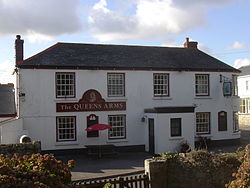Breage
| Breage Cornish: Eglosbrek | |
| Cornwall | |
|---|---|
 The Queen's Arms, Breage | |
| Location | |
| Grid reference: | SW615285 |
| Location: | 50°6’29"N, 5°19’55"W |
| Data | |
| Population: | 3,151 (2011) |
| Post town: | Helston |
| Postcode: | TR13 |
| Dialling code: | 01736 |
| Local Government | |
| Council: | Cornwall |
| Parliamentary constituency: |
St Ives |
Breage is a village in Cornwall, three miles west of Helston.
Other settlements in the parish include the villages of Ashton, Carleen and Godolphin Cross; the coastal village of Praa Sands; and the Great Work mine.
Breage is named after St Breaca, a missionary from Ireland (to whom the 15th-century church is dedicated)
Geography
The geological formation known as the Tregonning-Godolphin Granite (one of five granite outcrops of the Cornubian batholith in Cornwall) underlies the parish[1] and the area was formerly an important source of tin and copper ore. The area has evidence of habitation and mining for the past two millennia. Other than Praa Sands, the villages in the parish were tin and copper mining villages. Breage itself was where the mine owners (or captains) lived as evidenced by the number of fine buildings in the village. The village water pump (presumably now disconnected) still stands today as a relic of the past.
Most of today's working population are commuters, travelling to Helston, RNAS Culdrose, Porthleven, Penzance, Falmouth or even further afield. Some residents are still involved in farming or smallholding in the surrounding area.
Ashton (SW604286 is on the A394 Penzance-Helston road a mile north of Praa Sands. It has a pub called the Lion and Lamb and at one time had a football team.
The following hamlets are in the parish: Ashton; Broadlane; Carleen; Godolphin Cross; Gwedna; Hendra; Kenneggy; Millpool; Pengersick; Penhale Jakes; Polladras; Praa Sands; Rinsey; Rinsey Croft; Trenwheal; Trescowe; Tresoweshill; Trevena; and Trew.
Parish Church
The church was built of granite in the 15th century: on the north wall are five mediæval wall paintings. A Roman milestone of the 3rd century is preserved in the church and in the churchyard there is an unusual Hiberno-Saxon cross head.[2] The inscription on the milestone is: IMP [C] DO NO MARC CASSI: this incomplete text refers to the Marcus Cassianus Postumus, 258–68 AD (Collingwood, RIB no. 2232).[3]
History
The parish was at the time of Domesday Book within the manor of Binnerton. There were 8 hides of land with enough for 60 ploughs. There were 32 villagers and 25 smallholders with 15 ploughs between them. Apart from the arable land there was two acres of meadow, 2 square leagues of pasture and half a square league of woodland. Livestock were 45 mares, 13 cattle, 5 pigs and 60 sheep; the annual value was £10.[4]

Sport and recreation
Breage Playing Field is a Queen Elizabeth II Field.
Protected areas
Tregonning Hill, to the west of the parish, was designated a Site of Special Scientific Interest (SSSI) in 1994 for its biological interest.[1] 'Tremearne Par SSSI' and 'Porthcew SSSI', along the coast west of Porthleven, were designated for their geological interest and are also Geological Conservation Review sites.[5][6]
Great Wheal Fortune was a small mine in operation between 1855 and 1880 and produced 2992 tons of tin, 322 tons of copper and some arsenic and tungsten. In 1991 it was designated a SSSI and is also a Geological Conservation Review site of national importance.[7][8]
Outside links
| ("Wikimedia Commons" has material about Breage) |
References
- ↑ 1.0 1.1 SSSI listing and designation for Tregonning Hill
- ↑ Nikolaus Pevsner: The Buildings of England: Cornwall, 1951; 1970 Penguin Books ISBN 978-0-300-09589-0
- ↑ Collingwood, R. G.; Wright, R. P. (1965). The Roman Inscriptions of Britain. I: Inscriptions on stone. Oxford: Clarendon Press.
- ↑ Thorn, C. et al. (eds.) (1979) Cornwall. Chichester: Phillimore; entry 1.16
- ↑ SSSI listing and designation for Tremearne Par
- ↑ SSSI listing and designation for Porthcew
- ↑ Wheal Fortune – Graces Guide
- ↑ SSSI listing and designation for Wheal Fortune
